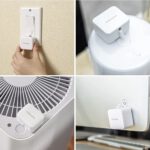You’re ready to venture into smart lighting and have decided to set up with Philips Hue products. A smart choice for nearly everyone, as Philips Hue lighting is highly reliable and widely supported. But how do you choose the right products? What kind of bulbs do you need, do you also need a hub, and what accessories are handy? In this article, we’ll go step by step through everything you need to know when getting started with Philips Hue lighting.
Hub or No Hub?
Philips Hue lighting can be used in two ways. The first way is via Bluetooth. You control your smart bulbs using your smartphone or tablet, but only when the bulbs are within Bluetooth range. This is the only way to control your smart bulbs. When using the Philips Hue Bridge, however, your bulbs communicate not directly with your phone via Bluetooth but via Zigbee with the bridge. The bridge is connected to the internet, enabling various control options for your bulbs at home and while away, such as through a smart assistant, automation, or a Philips Hue accessory. If you only want to occasionally control your smart bulbs with your phone when you’re at home, you might consider starting without a bridge. If you want to make the most of your smart lighting and also control your bulbs while away from home, then opt for purchasing the Philips Hue Bridge. This can be bought separately or as part of a starter kit, which usually includes smart bulbs and sometimes an accessory, and is often cheaper than buying these items separately.
Types of Bulbs
Philips Hue offers a wide range of smart bulbs. It’s important to determine which type of bulb you need. Begin by checking the type of fitting your lamp requires. The main types are GU10 (spotlights), E14, and E27. Usually, you can find this information on your current lamp to ensure the fitting is compatible.
Once you know the fitting type your lamp requires, the next step is to choose the color of your bulb. Philips Hue offers several categories:
The first option offers a single shade of white, which you can only dim. The second option, white ambiance, provides various shades of white, ranging from a bright blue-white to a warm yellow-white. The last option includes all colors, from white to red and green, allowing you to illuminate a space with a specific color.
Finally, there’s also the option to choose filament bulbs, where the filament is visible within the bulb. This can be a good choice for bulbs that are visible. These are available in the color options soft warm white and warm white to cool white.
In general, the more color options, the higher the price of your bulb. For instance, you might opt for a standard lamp without color options for a walk-in closet, while in the living room, it could add ambiance to choose one of the options that allow you to vary the color.
Accessories
Philips Hue offers various accessories to control your bulbs. The simplest is the Philips Hue Smart Button, which contains one button to turn your lights on or off. In the Philips Hue app, you can set how bright the bulbs should shine when you press the button. You can also link it to the time of day.
One of the most popular accessories is the Philips Hue Dimmer Switch. This is a small remote control that can be magnetically attached to a wall plate. The remote control has four buttons: on and off, brighter, dimmer, and a button to activate different light scenes.
Additionally, Philips Hue also offers the Tap Dial Switch, which also has four buttons to control different bulbs and light scenes. The button is also rotatable, allowing you to dim your lights by turning the dial.
The Philips Hue Wall Switch Module can also be very useful. This is a small device that you attach behind your existing light switch. This turns your existing light switch into a smart switch, allowing you to set which smart bulbs the switch controls and at what brightness the bulbs should turn on. This switch also prevents your smart bulbs from going offline if someone in your household uses the light switch to turn off your smart bulbs. At that moment, the bulb no longer receives power and cannot be controlled. The Philips Hue Wall Switch Module prevents this and ensures that your smart bulbs are always reachable.
Installation and Use
Once you have everything you need to start with Philips Hue, you first need to set up all the bulbs. The easiest way to do this is by downloading the Philips Hue app and following the instructions. You create different rooms in the app and add the smart bulbs to them. Then you set up the accessories to control the bulbs you want. After that, you can start using your smart lighting. If you want to do more with your smart bulbs, you can add them to your Google Home or Apple HomeKit (Home) app. This gives you an easy overview of all your devices and allows you to control them with this app and the accompanying smart assistant. It’s also possible to add automations to automatically turn your bulbs on and off based on time, location or another event.



